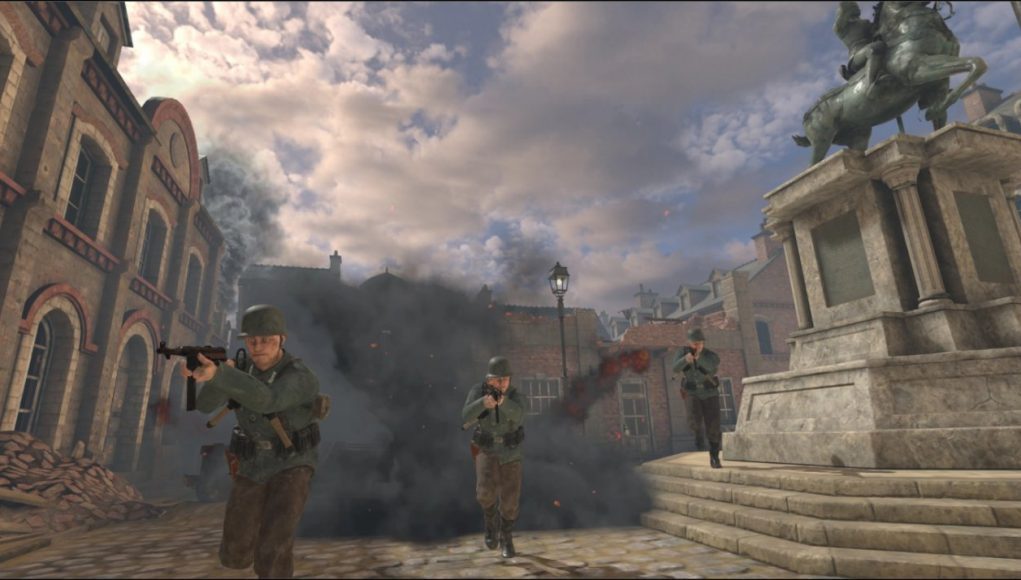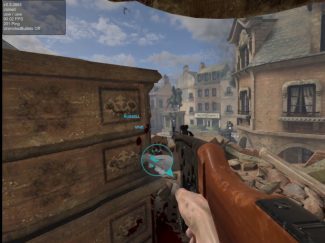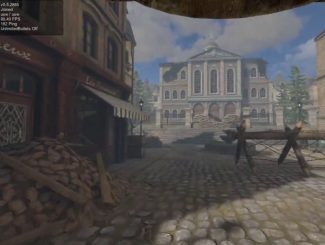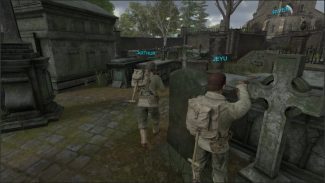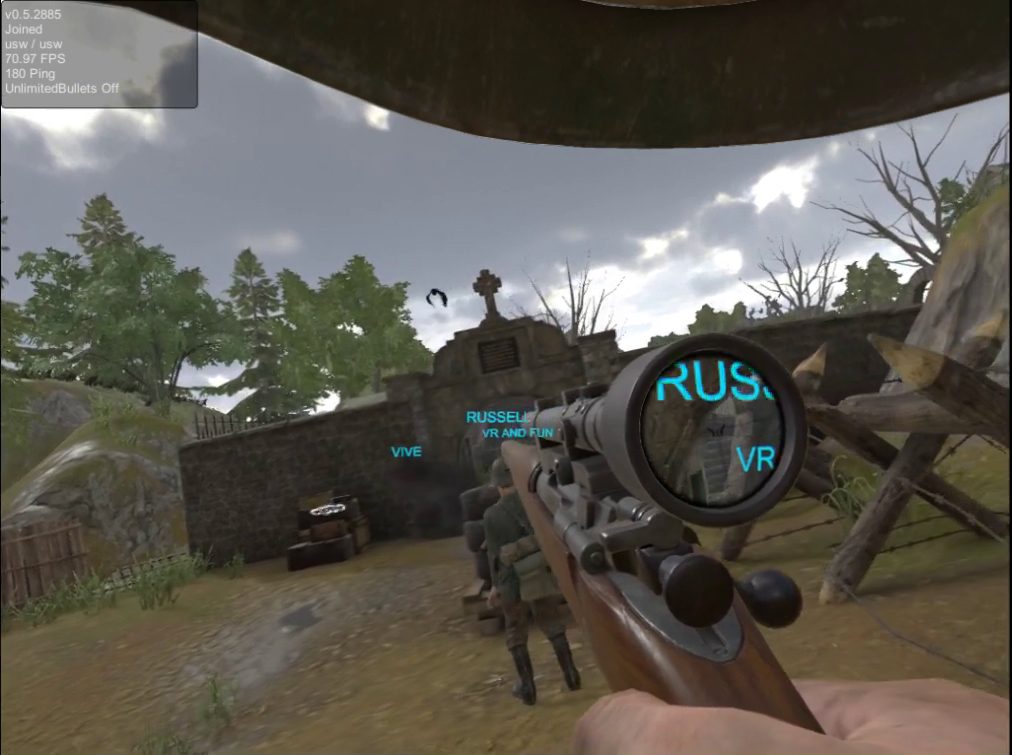Front Defense: Heroes (2017), Fantahorn’s next installment of its WWII-themed shooter, is available in Early Access today for HTC Vive, now serving up multiplayer action in classic 5v5 shooter fashion. We don’t score reviews in Early Access, which is probably a good thing, because several game-breaking bugs are simply too prominent to make this anything other than a quick diversion at the moment.
Front Defense: Heroes Details:
Developer: Fantahorn Studios
Publisher: Vive Studios
Available On: HTC Vive
Early Access Release Date: December 8th, 2017
Note: This game is in Early Access which means the developers have deemed it incomplete and likely to see changes over time. This review is an assessment of the game only at its current Early Access state and will not receive a numerical score.
Gameplay
Set near the grisly end of the World War 2, you can choose between Allied (only Americans currently) and Nazis, fighting it out across 5 typical maps; a French village, a church, city streets at night, an abandoned factory, and a train depot with an armored train. For now, only the train map presents anything other than a classic deathmatch by allowing a Counter Strike-style bomb planting mode.
Maps are very rough at this stage. I constantly had trouble walking through door frames, and got stuck several times in the maps’ geometry, although I was warned the pre-release version would have these sorts of bugs. During the match, the studio suggested dropping your gun to reset your position, but that never fixed the problem for me personally, leaving me to wait for the 5-minute round to be over before I was spawned back in at my team’s starting point. To its credit, the maps are both varied and interesting enough to keep you playing for a while.
Weapons classes aren’t limited to whichever team you pick, meaning an Allied player can decide to load-out with a typically Axis weapon like an MP-40 or Gewehr 43, which I found to be a big missed opportunity. Part of the fun in sneaking around in WW2 multiplayer games is indefinitely robbed when you roll up on a team full of Nazis and all you can hear is the noise of M1-carbines and Tommy guns.
The shooting experience wasn’t the most refined I’ve ever tried. Reloading is simple and clear, which is a big plus, making it so you’re never faffing around for your next magazine. Guns have appropriate recoil which is suppressed somewhat when you go two-handed. Much to my dismay, there’s an omnipresent crosshairs projected wherever you point, meaning you’ll never have to aim down the sites to get a clear shot.
Several times I grabbed a grenade and pulled the pin when trying to reload a magazine for my rifle, although in the pre-launch matches I played there was no friendly fire—annoying, but not penalizing.
Immersion
Unfortunately for a game that boasts realism, the rifles felt slightly smaller than they should be, although it’s much less noticeable in the game’s pistols: the Colt 1911 and the Pistole Parabellum 1908 (aka Nazi Luger). I’ve had a chance to fire an original full-stock M1 carbine and a modern-day replica of a Colt 1911, so I can speak from experience. The difference isn’t extreme, but still noticeable to anyone who’s handled firearms.
Unless you have a peripheral like a gun stock, shooting rifles in VR never quite feels right either. It’s never weighty enough, and dual-grips never give you the sense that you’re actually holding a solid weapon in your hands. That’s more of an issue with VR as a whole and not the game itself, so it’s hard to knock Front Defense: Heroes for being ineffectual in that respect.
Avatars leave much to the imagination at the moment immersion-wise. When engaged in automatic running (discussed in the ‘Comfort’ section), players are well-animated, replete with normal strides and normal postures. When you snap into normal room-scale locomotion though, the difference becomes immediately apparent. Several of my brothers and sisters in arms were set at incorrect heights, leaving some to walk on their tippy toes and others to float in the air at some points.
I mentioned before that I clipped several time through geometry. I want to revise that. About half the time I was playing, some combination of reloading, throwing grenades and walking had me fall through the world, or into buildings that aren’t normally accessible, which either left me completely immobile or with a newfound wall-hacking shooting advantage over other players. I was assured by the studio that this was an important issue they’re working on and will endeavor to fix some point before its release.
Comfort
Smooth locomotion is locked to your head, and not to your hand like VR shooter Onward (2017). Personally I find head-locked smooth motion much more comfortable than the former, but that comes down to player choice.
A big plus is the inclusion of third-person locomotion, like that seen in From Other Suns (2017), letting you ‘drive’ a remote-controlled version of yourself and instantly teleport to where you’ve stopped. The studio calls their version ‘V-move’. In the context of shooters, this level of physical continuity is important so you aren’t zooming around and dodging bullets, or popping out of view whenever you please, as you’re always vulnerable to enemy fire.
Guns are easily accessible once they’re on your person, but I would like to see more ‘force grabbing’ ability, as you have to physically bend down and pick up guns from the floor.
 We partnered with AVA Direct to create the Exemplar 2 Ultimate, our high-end VR hardware reference point against which we perform our tests and reviews. Exemplar 2 is designed to push virtual reality experiences above and beyond what’s possible with systems built to lesser recommended VR specifications.
We partnered with AVA Direct to create the Exemplar 2 Ultimate, our high-end VR hardware reference point against which we perform our tests and reviews. Exemplar 2 is designed to push virtual reality experiences above and beyond what’s possible with systems built to lesser recommended VR specifications.
Summary
For under $10, it’s hard not to take a chance on some WW2 deathmatch action. As it is now though, Front Defense: Heroes needs some serious TLC to become a trusted VR shooter that people will come back to. The core premise of the game is valid—essentially Day of Defeat in VR—but whether Fantahorn is able to put in the hours to make this rusty wheel eventually spin before its true consumer release… well … we’re hoping for the best.
Note: This game is in Early Access which means the developers have deemed it incomplete and likely to see changes over time. This review is an assessment of the game’s current state, and will not receive a numerical score.

